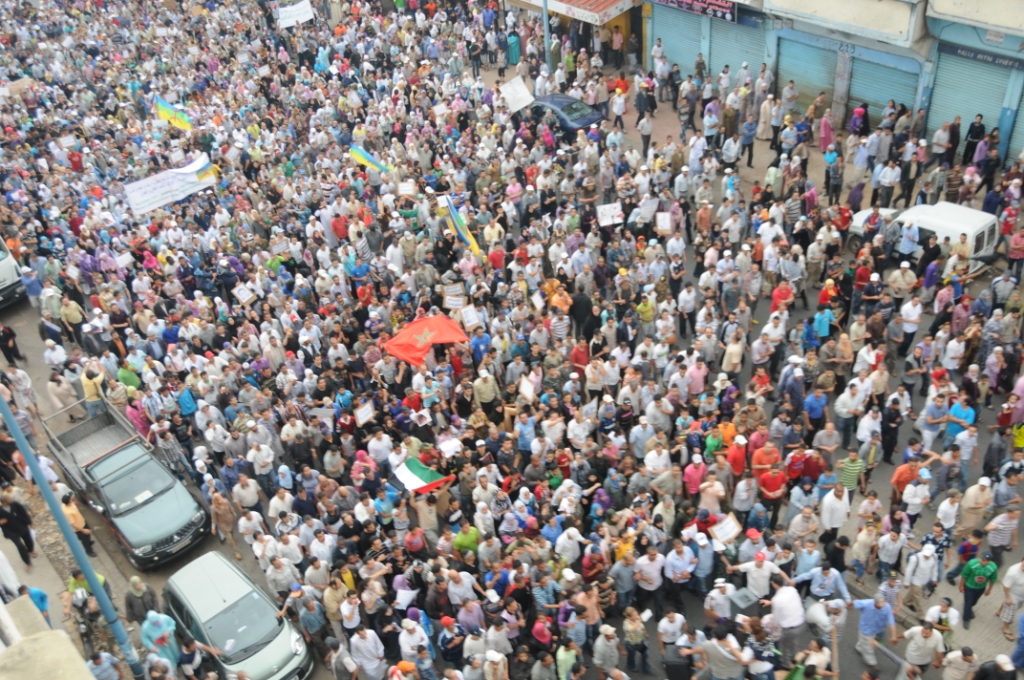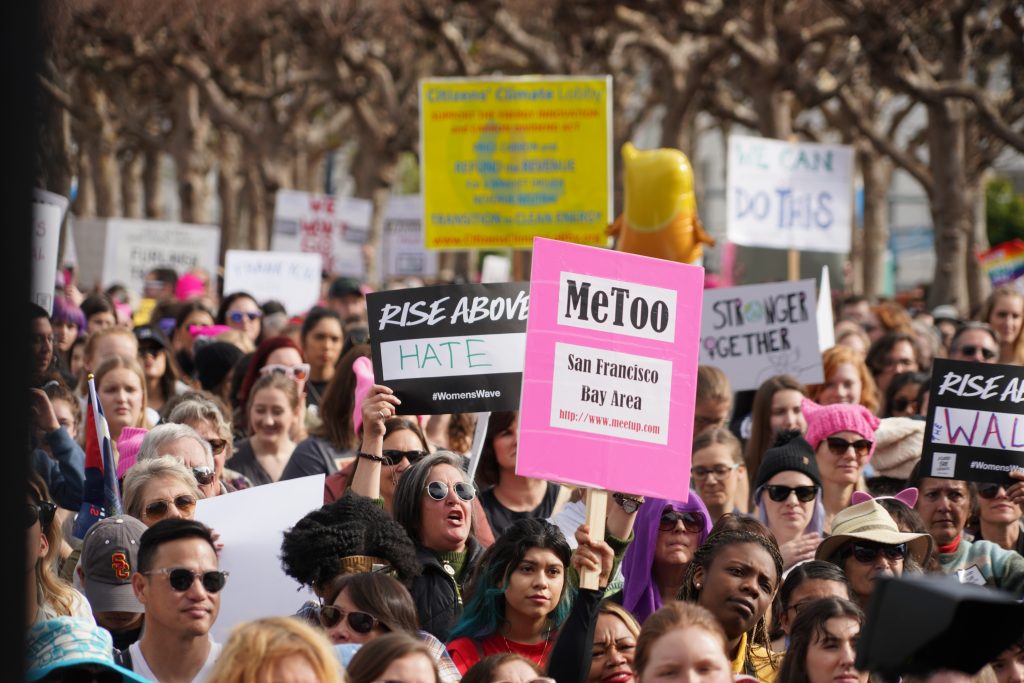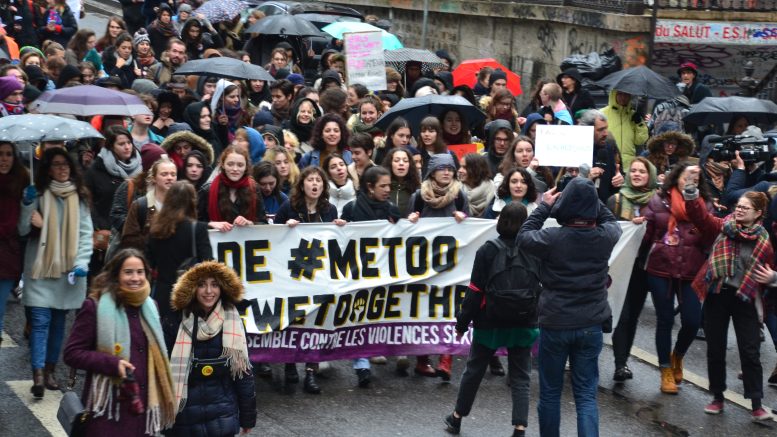“de #metoo à #wetogether” by Jeanne Menjoulet is licensed under CC BY-ND 2.0.
In recent years, from the MeToo movement to the Arab Spring, the scale and impact of protests around the globe, supported by social media, have rapidly expanded and shaken the world. Since the rise of social media, people have found new ways to express their concerns about social and political issues and their support for action. Social movements in this era are characterised by many features, such as changing profile photos, uploading specific content, and sharing short messages, slogans, or hashtags, leading to more people getting involved in discussions and actions on major issues. In the past, protests typically relied on traditional media and face-to-face interactions. However, the rise of social media has allowed individuals to quickly disseminate information, organise demonstrations, and connect with supporters without the need for intermediaries. This has provided social movements more opportunities and tools to become more global and persistent. Another common way to show support is to change the social media profile photo or adopt hashtags. For instance, during the #MeToo movement, many people changed their profile photos to the #MeToo logo to show their support for gender equality and opposition to sexual harassment. In #MeToo and the Arab Spring, #MeToo & #ArabSpring became an iconic hashtag representing the protests to track and discuss related events, this simple but strong hashtag can spread quickly, creating a global movement.
Youth Communities, Social Media, and the Spark of the Arab Spring
First of all, youth movements around the world have become increasingly connected to social media. And with the advent of the twenty-first century and the revolutionary changes that have taken place in the field of communications and social networks, Arab regimes have begun to lose their monopoly on information. Many young people began to realise that governments denied them the right to political participation tightly controlled their lives and invested almost nothing in the social, economic, and educational spheres (Vlasic & Cooper, 2011). As a result, they sought not ideology but personal dignity and respect. In 2010, protests in Tunisia spread across the world through social media, which in turn triggered large-scale protests against the government in a number of countries in the Middle East and North Africa (Zakarriya, 2023). The Arab Spring began with the seemingly random self-immolation of a vendor, but underneath the surface is a growing discontent with economic hardship, poverty, unemployment, and corruption. In other words, the situation of Arab youth and social development and the rise of social media have been indispensable factors in this political change.

“110609 ‘Arab Spring’ takes toll on Moroccan economy | ‘الربيع العربي’ يلقي بظلاله على الاقتصاد المغربي | Le Printemps arabe coûte à l’économie marocaine” by Magharebia is licensed under CC BY 2.0.
The #MeToo Movement: The Community Fightback Against Sexual Harassment in the Entertainment Industry
In October 2017, the U.S. movie industry erupted in a multiple sexual assault scandal involving famous film producer Harvey Weinstein. Actress Alyssa Milano encouraged women who had experienced the same to spread the word on Twitter. Milano encouraged women who had experienced the same thing to spread the word on Twitter: “If you’ve been sexually harassed or assaulted, write ‘me too’ as a reply to this tweet.”, and on November 12 of the same year, hundreds of people participated in the “#MeToo Survivors March” in Hollywood, and the following year, on the Oscars red carpet in the United States, celebrities responded to the “#MeToo” and “Time’s Up” campaigns with slogans, pins, and black dresses in order to protest against the evils of sexual assault.

“Woman’s March 2019: MeToo” by Lynn Friedman is licensed under CC BY-NC-ND 2.0.
The Role of Online Communities in #MeToo and the Arab Spring: Digital Empowerment and Global Amplification.
Online communities play an integral role in both movements, within the #MeToo community movement and the Arab Spring benefiting from the rise of social media and digital communication technologies. Both movements utilised platforms such as Twitter, Facebook, and Instagram in order to quickly disseminate information, organise demonstrations, and connect with supporters (O’Halloran & Cook, 2023; Zakarriya, 2023). Social media platforms provide a platform for victims to share their personal experiences and find support and empathy. With online community members providing emotional support and encouragement so that more people are brave enough to share their #MeToo stories, the social media community has helped fuel the spread of the #MeToo message (Hillstrom, 2019). By sharing posts, hashtags, and videos, the movement was able to spread globally. This helped generate widespread attention and social discussion, as well as active participation in social advocacy and policy reform, encouraging government, business, and society to take action to address sexual harassment (Zakarriya, 2023). Similarly, the online community in the Arab Spring used social media and online communities to organise demonstrations and disseminate political messages in several Arab countries. Social media helped the demonstrators coordinate their actions, scale up their protests, and bring the Arab Spring protests to the attention of the international community (Khondker, 2011). Foreign governments, media outlets, and activists connected with the Arab Spring’s online community to provide support and disseminate information, calling for greater political freedom and democracy through social media (Zakarriya, 2023).
With the increasing modernisation of social development, the awareness of the rights of the younger generation and women’s groups has been given unprecedented opportunities and broad space for development. The growth of young people’s awareness of their rights in the contemporary world is due to the process of marketisation, the globalised way of life, and networked interaction (Vlasic & Cooper, 2011; Smidi & Shahin, 2017). In particular, online communication has further expanded the space of the public sphere, building a broad platform for youth and women’s groups to pay attention to and participate in public affairs, and providing unprecedented opportunities for the emergence of a sense of rights. Therefore, political participation in social media implies the interests of youth and marginalised groups and the desire to utilise public power. When the channels of political participation in real political life are blocked and expression is suppressed, the grievances, attacks, and anti-establishment rhetoric of youth and women’s groups can quickly spread in the retaliatory form on the social media space.
Utilising the Power of Online Communities While Addressing Privacy Challenges
As mentioned above, social media and online communities have become powerful tools for awakening groups and social movements. They not only allow people to better express their concerns about social issues but also provide them with platforms for connection and action. However, privacy issues are also one of the challenges of social media. Sharing personal information and stories on social media can lead to privacy breaches that put individuals at risk. In the case of the #MeToo movement and the Arab Spring campaign, the sharing of victims’ experiences may lead to the disclosure of personal identity, exposing them to further distress. In facing these challenges, there is a need to balance the strengths and weaknesses of social media, this includes strengthening information verification mechanisms, protecting user privacy, developing strict abuse policies, and improving digital literacy to better utilise the potential of social media while reducing its negative impacts (Clarke, 2019). Social media has become an integral part of social movements, and understanding how to capitalize on its strengths and address challenges will be a key area for future research and social engagement.
Although the MeToo social movement and the Arab Spring differ in theme and scope, they are both examples of social movements in the digital age, showing how social media technologies and online communities have transformed the dissemination and impact of social movements. The online communities of both the #Metoo movement and the Arab Spring have helped to spark social change and spread important messages. These communities provided platforms that enabled victims to share experiences, advocate for political and social change, and build support systems. The role of online communities in both movements highlights the global and interconnected nature of social movements in the digital age. Moreover, the success of these two movements also demonstrates that through online organising and information dissemination, people can more effectively fight for their rights and protest against injustice. They also encapsulate the indispensable role of social media and online communication technologies in disseminating information and promoting social change, enabling protests and social movements to transcend national borders and attract international attention. As a result, digital culture has become a powerful tool for social movements, shaping the new patterns of modern social change.

Reference
Ahmed, S., & Madrid-Morales, D. (2021). Is it still a man’s world? Social media news use and gender inequality in online political engagement. Information, Communication & Society, 24(3), 381–399. https://doi.org/10.1080/1369118X.2020.1851387
Ashwarya, S., & Alam, M. (2022). The Arab Spring: Ten Years On. Gerlach Press. https://doi.org/10.2307/j.ctv2n37kbw
Clarke, Jessica A. (2019) “The Rules of #MeToo,” University of Chicago Legal Forum: Vol. 2019 , Article 3. https://chicagounbound.uchicago.edu/uclf/vol2019/iss1/3
De Zúñiga, H. G., Barnidge, M., & Scherman, A. (2016). Social media social capital, offline social capital, and Citizenship: Exploring Asymmetrical social capital Effects. Political Communication, 34(1), 44–68. https://doi.org/10.1080/10584609.2016.1227000
Hillstrom, L. C. (2019). The #MeToo movement. ABC-CLIO.
Khondker, H. H. (2011). Role of the new media in the Arab Spring. Globalizations, 8(5), 675–679. https://doi.org/10.1080/14747731.2011.621287
Langone, A. (2018, March 22). #MeToo and Time’s Up Founders Explain the Difference Between the 2 Movements — And How They’re Alike. Time. https://time.com/5189945/whats-the-difference-between-the-metoo-and-times-up-movements/
O’Halloran, O., & Cook, N. (2023). Breaking the silence: exploring women’s experiences of participating in the #MeToo movement. Feminist Media Studies, 1–15. https://doi.org/10.1080/14680777.2023.2231656
Sayej, N. (2018, March 11). Alyssa Milano on the #MeToo movement: “We’re not going to stand for it any more.” The Guardian. https://www.theguardian.com/culture/2017/dec/01/alyssa-milano-mee-too-sexual-harassment-abuse
Smidi, A., & Shahin, S. (2017). Social Media and Social Mobilisation in the Middle East: A Survey of Research on the Arab Spring. India Quarterly, 73(2), 196–209. https://www.jstor.org/stable/48505308
Sapra, B. (2020, January 14). The last decade showed how social media could topple governments and make social change — and it’s only getting crazier from here. Business Insider. https://www.businessinsider.com/social-media-activism-facebook-twitter-youtube-power-2019-12
Vlasic, M. V., & Cooper, G. (2011). Beyond the Duvalier legacy: what new “Arab Spring” governments can learn from Haiti and the benefits of stolen asset recovery. Northwestern University Journal of International Human Rights, 10(1-2), 19–.
Zakarriya, J. (2023). #MeToo in the Post–Arab Spring era. In Oxford University Press eBooks (pp. 248-C14P131). https://doi.org/10.1093/oso/9780197619872.003.0014




Be the first to comment on "Online Communities’ Role in Modern Social Movements: From the Arab Spring to #Metoo"